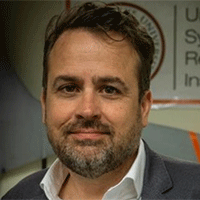
Jamey D. Jacob
Oklahoma Aerospace Institute for Research and Education
Presenting in Track 5: Advances in Aerospace Technology
Presentation Title: Putting the AI in Advanced Air Mobility
Abstract: The promulgation of unmanned aircraft systems (UAS) as a ubiquitous platform has generated both aviation opportunities and challenges, particularly when it comes to integration into the NAS (national airspace). Likewise, increasingly larger autonomous aircraft in the form of advanced air mobility (AAM) systems will also require unique solutions. Each will require new systems and approaches for integration into the NAS and require navigation solutions as part of the unmanned traffic management (UTM) network development and implementation. In particular, the challenges of sensing hazards include non-traditional risks from environmental parameters such as high spatial turbulence gradients, high turbulence magnitudes, and degraded position references, all of which complicate the traditional approach. This is particularly true in urban environments where the presence of buildings produces not only obstacles but also complex, unsteady flow patterns. Local wind-field sensing onboard AAM is often approached via combining relative sensing and inertial reference measurements. Swarming and mesh network topologies are attractive for integrating additional sensing platforms into this measurement challenge. In addition, the threat of midair collisions between unmanned and manned aircraft in the NAS represents an unknown risk of integrating operations between disparate airspace users. This will be a vexing issue for the integration of urban air mobility (UAM) solutions as part of UTM development and implementation. This presentation discusses integration approaches and field tests for utilizing tools such as AI to provide real-time data to inform the UTM and enable AAM operations by addressing emerging needs in real-time weather forecasting to improve the safety of low altitude aircraft operations through the integration of real-time observations from autonomous systems with numerical weather prediction and flight management and safety systems, thus improving the resolution and accuracy of comprehensive environmental and hazard estimation, which is critical to improving safety and operational efficiency.
Biography: Jamey Jacob is the Executive Director of the OSU Oklahoma Aerospace Institute for Research and Education (OAIRE) and the Williams Chair in Energy Technology and Regents Professor of Aerospace Engineering in the School of Mechanical and Aerospace Engineering at Oklahoma State University. His current efforts are focused on emerging technology and the societal impact of advanced mobility and their enhanced operation in the national airspace for broader innovative applications. He is currently lead on the NASA University Leadership Initiative program WINDMAP to develop aviation weather solutions for advanced aerial mobility applications, including drones and urban air taxis. He is the director for the Counter-UAS Center of Excellence focused on assessing and mitigating UAS threats both at home and abroad. As part of recent EDA funding through the Build Back Better program, he is leading the development of the LaunchPad Center for Advanced Air Mobility in Tulsa and affiliated Skyway Range operated by the Osage Nation and the associated Tech Hubs for trusted and equitable autonomy. He received his B.S. in Aerospace Engineering from the University of Oklahoma in 1990 and his M.S and Ph.D. in Mechanical Engineering from the University of California at Berkeley in 1992 and 1995, respectively. He was a National Research Council Summer Faculty Fellow in the Air Force Research Laboratory and received the SAE Ralph Teetor Award, the Lockheed Martin Teaching Award, and the OSU Regents Distinguished Teaching and Research Awards, among other mentoring accolades. He is a native Oklahoman and dedicates much of his efforts to STEM workforce development, tribal engagement, and increasing diversity in engineering and science.